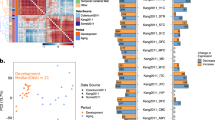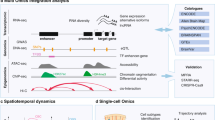Abstract
Brain development and function depend on the precise regulation of gene expression. However, our understanding of the complexity and dynamics of the transcriptome of the human brain is incomplete. Here we report the generation and analysis of exon-level transcriptome and associated genotyping data, representing males and females of different ethnicities, from multiple brain regions and neocortical areas of developing and adult post-mortem human brains. We found that 86 per cent of the genes analysed were expressed, and that 90 per cent of these were differentially regulated at the whole-transcript or exon level across brain regions and/or time. The majority of these spatio-temporal differences were detected before birth, with subsequent increases in the similarity among regional transcriptomes. The transcriptome is organized into distinct co-expression networks, and shows sex-biased gene expression and exon usage. We also profiled trajectories of genes associated with neurobiological categories and diseases, and identified associations between single nucleotide polymorphisms and gene expression. This study provides a comprehensive data set on the human brain transcriptome and insights into the transcriptional foundations of human neurodevelopment.
This is a preview of subscription content, access via your institution
Access options
Subscribe to this journal
Receive 51 print issues and online access
$199.00 per year
only $3.90 per issue
Buy this article
- Purchase on Springer Link
- Instant access to full article PDF
Prices may be subject to local taxes which are calculated during checkout






Similar content being viewed by others
Accession codes
References
Kostovic, I. & Judas, M. Prolonged coexistence of transient and permanent circuitry elements in the developing cerebral cortex of fetuses and preterm infants. Dev. Med. Child Neurol. 48, 388–393 (2006)
Rakic, P. Evolution of the neocortex: a perspective from developmental biology. Nature Rev. Neurosci. 10, 724–735 (2009)
Rubenstein, J. L. Annual Research Review: Development of the cerebral cortex: implications for neurodevelopmental disorders. J. Child Psychol. Psychiatry 52, 339–355 (2011)
Preuss, T., Cáceres, M., Oldham, M. & Geschwind, D. Human brain evolution: insights from microarrays. Nature Rev. Genet. 5, 850–860 (2004)
Hill, R. S. & Walsh, C. A. Molecular insights into human brain evolution. Nature 437, 64–67 (2005)
Lewis, D. A. & Levitt, P. Schizophrenia as a disorder of neurodevelopment. Annu. Rev. Neurosci. 25, 409–432 (2002)
Meyer-Lindenberg, A. & Weinberger, D. R. Intermediate phenotypes and genetic mechanisms of psychiatric disorders. Nature Rev. Neurosci. 7, 818–827 (2006)
Insel, T. Rethinking schizophrenia. Nature 468, 187–193 (2010)
State, M. The genetics of child psychiatric disorders: focus on autism and Tourette syndrome. Neuron 68, 254–269 (2010)
Jamain, S. et al. Mutations of the X-linked genes encoding neuroligins NLGN3 and NLGN4 are associated with autism. Nature Genet. 34, 27–29 (2003)
Vawter, M. et al. Gender-specific gene expression in post-mortem human brain: localization to sex chromosomes. Neuropsychopharmacology 29, 373–384 (2004)
Weickert, C. et al. Transcriptome analysis of male-female differences in prefrontal cortical development. Mol. Psychiatry 14, 558–561 (2009)
Reinius, B. & Jazin, E. Prenatal sex differences in the human brain. Mol. Psychiatry 14, 988–989 (2009)
Abrahams, B. et al. Genome-wide analyses of human perisylvian cerebral cortical patterning. Proc. Natl Acad. Sci. USA 104, 17849–17854 (2007)
Sun, T. et al. Early asymmetry of gene transcription in embryonic human left and right cerebral cortex. Science 308, 1794–1798 (2005)
Johnson, M. et al. Functional and evolutionary insights into human brain development through global transcriptome analysis. Neuron 62, 494–509 (2009)
Somel, M. et al. MicroRNA, mRNA, and protein expression link development and aging in human and macaque brain. Genome Res. 20, 1207–1218 (2010)
Ip, B. et al. Investigating gradients of gene expression involved in early human cortical development. J. Anat. 217, 300–311 (2010)
Licatalosi, D. D. & Darnell, R. B. Splicing regulation in neurologic disease. Neuron 52, 93–101 (2006)
Blencowe, B. J. Alternative splicing: new insights from global analyses. Cell 126, 37–47 (2006)
Svenningsson, P. et al. Alterations in 5–HT1B receptor function by p11 in depression-like states. Science 311, 77–80 (2006)
Chen, D. Y. et al. A critical role for IGF-II in memory consolidation and enhancement. Nature 469, 491–497 (2011)
Lehtinen, M. K. et al. The cerebrospinal fluid provides a proliferative niche for neural progenitor cells. Neuron 69, 893–905 (2011)
Huffaker, S. J. et al. A primate-specific, brain isoform of KCNH2 affects cortical physiology, cognition, neuronal repolarization and risk of schizophrenia. Nature Med. 15, 509–518 (2009)
Joutel, A. et al. Notch3 mutations in CADASIL, a hereditary adult-onset condition causing stroke and dementia. Nature 383, 707–710 (1996)
Ewart, A. K. et al. Hemizygosity at the elastin locus in a developmental disorder, Williams syndrome. Nature Genet. 5, 11–16 (1993)
Südhof, T. C. Neuroligins and neurexins link synaptic function to cognitive disease. Nature 455, 903–911 (2008)
Zhang, B. & Horvath, S. A general framework for weighted gene co-expression network analysis. Stat. Appl. Genet. Mol. Biol. 4, article17 (2005)
Hansen, D. V., Rubenstein, J. L. & Kriegstein, A. R. Deriving excitatory neurons of the neocortex from pluripotent stem cells. Neuron 70, 645–660 (2011)
Hevner, R. et al. Tbr1 regulates differentiation of the preplate and layer 6. Neuron 29, 353–366 (2001)
Molyneaux, B. J., Arlotta, P., Hirata, T., Hibi, M. & Macklis, J. D. Fezl is required for the birth and specification of corticospinal motor neurons. Neuron 47, 817–831 (2005)
Chen, B., Schaevitz, L. & McConnell, S. Fezl regulates the differentiation and axon targeting of layer 5 subcortical projection neurons in cerebral cortex. Proc. Natl Acad. Sci. USA 102, 17184–17189 (2005)
Chen, J., Rasin, M., Kwan, K. & Sestan, N. Zfp312 is required for subcortical axonal projections and dendritic morphology of deep-layer pyramidal neurons of the cerebral cortex. Proc. Natl Acad. Sci. USA 102, 17792–17797 (2005)
Ariani, F. et al. FOXG1 is responsible for the congenital variant of Rett syndrome. Am. J. Hum. Genet. 83, 89–93 (2008)
Kwan, K. et al. SOX5 postmitotically regulates migration, postmigratory differentiation, and projections of subplate and deep-layer neocortical neurons. Proc. Natl Acad. Sci. USA 105, 16021–16026 (2008)
Knoth, R. et al. Murine features of neurogenesis in the human hippocampus across the lifespan from 0 to 100 years. PLoS ONE 5, e8809 (2010)
Han, W. et al. TBR1 directly represses Fezf2 to control the laminar origin and development of the corticospinal tract. Proc. Natl Acad. Sci. USA 108, 3041–3046 (2011)
McKenna, W. L. et al. Tbr1 and Fezf2 regulate alternate corticofugal neuronal identities during neocortical development. J. Neurosci. 31, 549–564 (2011)
Perroud, N. et al. Genome-wide association study of increasing suicidal ideation during antidepressant treatment in the GENDEP project. Pharmacogenomics J. advance online publication, 〈http://dx.doi.org/10.1038/tpj.2010.70〉 (2010)
Stefansson, H. et al. Common variants conferring risk of schizophrenia. Nature 460, 744–747 (2009)
Petanjek, Z., Judas, M., Kostovic´, I. & Uylings, H. Lifespan alterations of basal dendritic trees of pyramidal neurons in the human prefrontal cortex: a layer-specific pattern. Cereb. Cortex 18, 915–929 (2008)
Huttenlocher, P. R. & Dabholkar, A. S. Regional differences in synaptogenesis in human cerebral cortex. J. Comp. Neurol. 387, 167–178 (1997)
Stranger, B. E. et al. Population genomics of human gene expression. Nature Genet. 39, 1217–1224 (2007)
Heinzen, E. L. et al. Tissue-specific genetic control of splicing: implications for the study of complex traits. PLoS Biol. 6, e1 (2008)
Liu, C. et al. Whole-genome association mapping of gene expression in the human prefrontal cortex. Mol. Psychiatry 15, 779–784 (2010)
Gibbs, J. R. et al. Abundant quantitative trait loci exist for DNA methylation and gene expression in human brain. PLoS Genet. 6, e1000952 (2010)
Myers, A. J. et al. A survey of genetic human cortical gene expression. Nature Genet. 39, 1494–1499 (2007)
Webster, J. A. et al. Genetic control of human brain transcript expression in Alzheimer disease. Am. J. Hum. Genet. 84, 445–458 (2009)
Ren, C., Ren, C. H., Li, L., Goltsov, A. A. & Thompson, T. C. Identification and characterization of RTVP1/GLIPR1-like genes, a novel p53 target gene cluster. Genomics 88, 163–172 (2006)
Colantuoni, C. et al. Temporal dynamics and genetic control of transcription in the human prefrontal cortex. Nature 10.1038/nature10524 (this issue)
Acknowledgements
We thank A. Belanger, V. Imamovic, R. Johnson, P. Larton, S. Lindsay, B. Poulos, J. Rajan, D. Rimm and R. Zielke for assistance with tissue acquisition, D. Singh for technical assistance, I. Kostovic and Z. Petanjek for dendrite measurements, P. Levitt for suggesting the inclusion of ITC in the study, and D. Karolchik and A. Zweig for help in creating tracks for the UCSC Genome Browser. We also thank A. Beckel-Mitchener, M. Freund, M. Gerstein, D. Geschwind, T. Insel, M. Judas, J. Knowles, E. Lein, P. Levitt, N. Parikshak and members of the Sestan laboratory for discussions and criticism. Tissue was obtained from several sources including the Human Fetal Tissue Repository at the Albert Einstein College of Medicine, the NICHD Brain and Tissue Bank for Developmental Disorders at the University of Maryland, the Laboratory of Developmental Biology at the University of Washington (supported by grant HD000836 from the Eunice Kennedy Shriver National Institute of Child Health and Human Development) and the Joint MRC/Wellcome Trust Human Developmental Biology Resource (http://hdbr.org) at the IHG, Newcastle Upon Tyne (UK funding awards G0700089 and GR082557). Support for predoctoral fellowships was provided by the China Scholarship Council (Y.Z.), the Portuguese Foundation for Science and Technology (A.M.M.S.), the Samsung Scholarship Foundation (Y.S.), a Fellowship of the German Academic Exchange Service – DAAD (S. Mayer) and NIDA grant DA026119 (T.G.). This work was supported by grants from the US National Institutes of Health (MH081896, MH089929, NS054273), the Kavli Foundation and NARSAD, and by a James S. McDonnell Foundation Scholar Award (N.S.).
Author information
Authors and Affiliations
Contributions
H.J.K., Y.I.K., A.M.M.S., M.P., K.A.M., G.S., Y.S., M.B.J., Z.K., S. Mayer, S.F., S.U., S. Mane and N.S. performed and analysed the experiments. F.C., Y.Z., X.X., M.L., T.G. and M.R. analysed the data. Z.K., A.M.M.S., M.P., G.S., S.N.L, A.V., D.R.W., T.M.H., A.H., J.E.K. and N.S. participated in tissue procurement and examination. N.S. designed the study and wrote the manuscript, which all authors commented and edited.
Corresponding author
Ethics declarations
Competing interests
The authors declare no competing financial interests.
Supplementary information
Supplementary Information
This file contains Supplementary Text, Data and Methods (1-9 ) - see Contents for full details, (10 ) Supplementary References, (11) Legends for Supplementary Tables 1-17 (see separate excel file for tables), and (12) Supplementary Figures 1-25 with legends. (PDF 7421 kb)
Supplementary Tables
This file contains Supplementary Tables 1-17 (see Supplementary Information file for more details). (XLS 3463 kb)
Rights and permissions
About this article
Cite this article
Kang, H., Kawasawa, Y., Cheng, F. et al. Spatio-temporal transcriptome of the human brain. Nature 478, 483–489 (2011). https://doi.org/10.1038/nature10523
Received:
Accepted:
Published:
Issue Date:
DOI: https://doi.org/10.1038/nature10523
This article is cited by
-
Convergent and divergent genes expression profiles associated with brain-wide functional connectome dysfunction in deficit and non-deficit schizophrenia
Translational Psychiatry (2024)
-
Engineered serum markers for non-invasive monitoring of gene expression in the brain
Nature Biotechnology (2024)
-
Altered excitatory and inhibitory ionotropic receptor subunit expression in the cortical visuospatial working memory network in schizophrenia
Neuropsychopharmacology (2024)
-
An epigenetic barrier sets the timing of human neuronal maturation
Nature (2024)
-
Structural connectome architecture shapes the maturation of cortical morphology from childhood to adolescence
Nature Communications (2024)
Comments
By submitting a comment you agree to abide by our Terms and Community Guidelines. If you find something abusive or that does not comply with our terms or guidelines please flag it as inappropriate.



